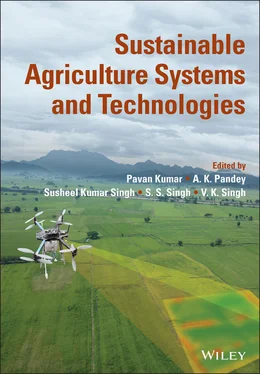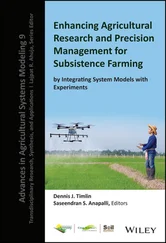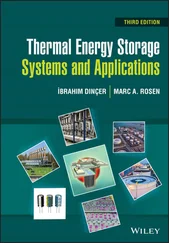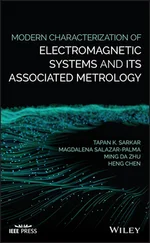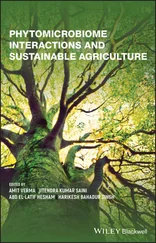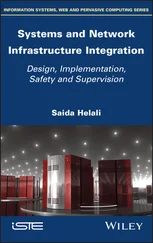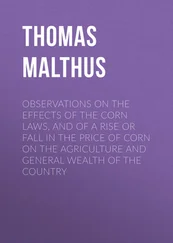Sustainable Agriculture Systems and Technologies
Здесь есть возможность читать онлайн «Sustainable Agriculture Systems and Technologies» — ознакомительный отрывок электронной книги совершенно бесплатно, а после прочтения отрывка купить полную версию. В некоторых случаях можно слушать аудио, скачать через торрент в формате fb2 и присутствует краткое содержание. Жанр: unrecognised, на английском языке. Описание произведения, (предисловие) а так же отзывы посетителей доступны на портале библиотеки ЛибКат.
- Название:Sustainable Agriculture Systems and Technologies
- Автор:
- Жанр:
- Год:неизвестен
- ISBN:нет данных
- Рейтинг книги:5 / 5. Голосов: 1
-
Избранное:Добавить в избранное
- Отзывы:
-
Ваша оценка:
- 100
- 1
- 2
- 3
- 4
- 5
Sustainable Agriculture Systems and Technologies: краткое содержание, описание и аннотация
Предлагаем к чтению аннотацию, описание, краткое содержание или предисловие (зависит от того, что написал сам автор книги «Sustainable Agriculture Systems and Technologies»). Если вы не нашли необходимую информацию о книге — напишите в комментариях, мы постараемся отыскать её.
A robust treatment of traditional and new techniques in sustainable agriculture Sustainable Agriculture Systems and Technologies,
Sustainable Agriculture Systems and Technologies
Sustainable Agriculture Systems and Technologies — читать онлайн ознакомительный отрывок
Ниже представлен текст книги, разбитый по страницам. Система сохранения места последней прочитанной страницы, позволяет с удобством читать онлайн бесплатно книгу «Sustainable Agriculture Systems and Technologies», без необходимости каждый раз заново искать на чём Вы остановились. Поставьте закладку, и сможете в любой момент перейти на страницу, на которой закончили чтение.
Интервал:
Закладка:
References
1 Cardinale, B.J., Duffy, J.E., Gonzalez, A. et al. (2012). Biodiversity loss and its impact on humanity. Nature 486: 59–67.
2 FAO (2009). State of the World’s Forests 2009. Rome: FAO http://www.fao.org/docrep/011/i0350e/i0350e00.htm.
3 Gurr, G.M., Wratten, S.D., and Luna, J.M. (2003). Multi‐function agricultural biodiversity: pest management and other benefits. Basic and Applied Ecology 4 (2): 107–116. https://doi.org/10.1078/1439‐1791‐00122.
4 Jogendra, S., Lyngdoh, Y.A., and Lata, S. (2019). Diversification through vegetable cultivation for doubling farmer's income. In: Crop Diversification for Resilience in Agriculture and Doubling Farmers Income (eds. S.S. Rathore, K. Shekhawat, G.A. Rajanna, et al.), 210. Pusa, New Delhi: ICAR –Indian Agricultural Research Institute (IARI), ISBN:978‐93‐83168‐42‐2.
5 Palaniappan, S.P. and Jeyabal, A. (2002). Crop diversification with oilseeds in non‐traditional areas andseasons. In: Oilseeds and Oils: Research and Development Needs (eds. M. Rai, S. Harvir and D.M. Hegde), 94–100. Hyderabad: Indian Society of Oilseeds Research.
6 Perfecto, I. and Vandermeer, J. (2008). Biodiversity conservationin tropical agroecosystems: a new conservation paradigm. The Year in Ecology and Conservation Biology 1134: 173–200.
7 Polasky, S. (2008). What's nature done for you lately: measuring the value of ecosystem services. Choices: The Magazine of Food, Farm, and Resource Issues 23: 42–46.
8 Rathore, S.S. and Bhatt, B.P. (2008). Productivity improvement in jhum fields through integrated farming system. Indian Journal of Agronomy 53 (3): 167–171.
9 Rathore, S.S. and Shekhawat, K. (2020). Climate Smart Agronomy. Bhavya Books (BET) page 260. ISBN 978‐93‐83992‐49‐2.
10 Rathore, S.S., Shekhawat, K., Rajanna, G.A. et al. (2019). Crop Diversification for Resilience in Agriculture and Doubling Farmers Income, 210. Pusa, New Delhi: ICAR –Indian Agricultural Research Institute (IARI), ISBN:978‐93‐83168‐42‐2.
11 Rathore, S.S., Shekhawat, K., Singh, R.K. et al. (2020). Zinc management for higher productivity and profitability under diversified fodder maize based systems in semi‐arid conditions. Range Management and Agroforestry 41 (2): 316–321.
12 Reddy, B.N. and Suresh, G. (2006). Crop diversification with oilseed crops for‐maximizing productivity, profitability and resource conservation. Indian Journal of Agronomy 54 (2): 206–214.
13 Renard, D. and Tilman, D. (2019). National food production stabilized by crop diversity. Nature 571: 257–260.
14 Saha, R., Chaudhary, S., and Somasundaram, J. (2012). Soil health management under hill agro ecosystem of north east India. Applied and Environmental Soil Science https://doi.org/10.1155/2012/696174.
15 Singh, V.K., Sharma, B.B., and Dwivedi, B.S. (2002). The impact of diversification of a rice–wheat cropping system on crop productivity and soil fertility. Journal of Agricultural Science 139: 405–412. https://doi.org/10.1017/S0021859602002666.
16 Singh, K.K., Ali, M., and Venkatesh, M.S. (2009). Pulses in Cropping Systems. Technical Bulletin. Kanpur: IIPR.
17 Singh, V.K., Rathore, S.S., Singh, R.K. et al. (2020). Integrated farming system approach for enhanced farm productivity, climate resilience and doubling farmers' income. Indian Journal of Agricultural Sciences 90 (8): 1378–1388.
18 Tamburini, G., Bommarco, R., Wanger, T.C. et al. (2020). Agricultural diversification promotes multiple ecosystem services without compromising yield. Science Advances 6: eaba1715.
19 TEEB (2010). The Economics of Ecosystems and Biodiversity. Ecological and Economic Foundations. Abingdon: Routledge.
20 Vanbergena Adam, J., Aizenb, M.A., Cordeaua, S. et al. (2020). Transformation of agricultural landscapes in the Anthropocene: nature's contributions to people, agriculture and food security. Advances in Ecological Research https://doi.org/10.1016/bs.aecr.2020.08.002.
21 Wagg, C., Bender, S.F., Widmer, F., and van der Heijden, M.G. (2014). Soil biodiversity and soil community composition determine ecosystem multifunctionality. Proceedings. National Academy of Sciences. United States of America 111: 5266–5270.
3 Impact of Total Mixed Ration on Performance of Heifers and Homemade Concentrate Feeding on Milk Yield in Dairy Animals
A. Dey1, B.P. Bhatt2, and J. J. Gupta1
1 ICAR Research Complex for Eastern Region, Patna, Bihar, India
2 NRM Division, Indian Council of Agricultural Research, New Delhi, India
CONTENTS
3.1 Introduction
3.2 Materials and Methods3.2.1 Effect of TMR on Milk Yield and Nutrients Digestibility in Crossbred Cows 3.2.2 Effect of Homemade Balanced Concentrate Feed on Milk Yield and Nutrients Intake in Crossbred Cows
3.3 Results and Discussion3.3.1 Effect of TMR on Milk Yield and Nutrients Digestibility in Crossbred Cows 3.3.2 Effect of Homemade Balanced Concentrate Feed on Milk Yield and Nutrients Intake in Crossbred Cows
3.4 Conclusion and Future Prospects
References
3.1 Introduction
Small holder dairy animals thrive on crop by‐products and residues with open grazing in field. Very little concentrate mixture is generally fed to the animals, which are often unbalanced based on the availability with the farmers at home. Analysis of nutritional status of animals before ration balancing revealed that 89.4 and 60.9% animals were overfed in terms of TDN and crude protein (CP), respectively and 45.8 and 76% of the animals were underfed in terms of Ca and P, respectively in Gujarat (Garg et al. 2009). In Bihar, Dey and Kaushal (2006) observed 10–27% gap in DCP intake and 5–10% gap in TDN intake in lactating animals. Traditionally in India, forage and concentrate are fed separately to the dairy animals, which sometime results in higher risk of ruminal acidosis particularly in high yielders due to improper nutrients supply and thereby low reproductive and productive performance (Maekawa et al. 2002; Gupta et al. 2016). However, in many parts of India, particularly in wheat growing areas of northern India, in contrary to this, total mixed ration (TMR) feeding is a way to improve rumen conditions by supplying balanced nutrients at a time in the rumen which are essential for better utilization of nutrients (Bargo et al. 2003). It has been reported that supplementation of energy and protein in the diet improves average daily gain (ADG) in Holstein heifers and reduces rearing costs (Zanton and Heinrichs 2007). But at the same time, majority of the farmers in eastern India follow resource‐based separate feeding of roughages and concentrates (Gupta et al. 2014a). Following scientific feeding and management practices, feed conversion efficiency and profitability could be increased and green house gases (GHGs) emission could be reduced (Makkar 2016). For production of 1 kg milk or meat, GHG emission can be reduced by 25% by 10% improvement in digestibility. However, the sustainability of precession feeding is questionable due to poor infrastructure and maintenance support in developing countries (Makkar 2016). TMR ( sani feeding system) and preparation of homemade balanced concentrate feed are two low cost technologies that can be widely disseminated in India. Ration balancing programme has extensively been applied by NDDB in different states of India (Garg et al. 2009; Garg and Bhanderi 2011). Recently few workers have observed positive effect in sani feeding system. Somvanshi et al. (2017) observed improvement in milk production by 15.78% following sani feeding technique with supplementation of mineral mixture as compared to farmer practice i.e. roughages without minerals. However, Gupta et al. (2014b) reported that inclusion of concentrate feed to the TMR @1.5% body weight was beneficial in crossbred heifers in respect of body weight gain and nutrients digestibility as compared to concentrate mixture @1% of body weight.
Читать дальшеИнтервал:
Закладка:
Похожие книги на «Sustainable Agriculture Systems and Technologies»
Представляем Вашему вниманию похожие книги на «Sustainable Agriculture Systems and Technologies» списком для выбора. Мы отобрали схожую по названию и смыслу литературу в надежде предоставить читателям больше вариантов отыскать новые, интересные, ещё непрочитанные произведения.
Обсуждение, отзывы о книге «Sustainable Agriculture Systems and Technologies» и просто собственные мнения читателей. Оставьте ваши комментарии, напишите, что Вы думаете о произведении, его смысле или главных героях. Укажите что конкретно понравилось, а что нет, и почему Вы так считаете.
